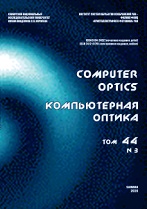|
This article is cited in 4 scientific papers (total in 4 papers)
OPTO-IT
Focusing fractional-order cylindrical vector beams
V. D. Zaitsevab, S. S. Stafeevba
a IPSI RAS – Branch of the FSRC "Crystallography and Photonics" RAS,
443001, Samara, Russia, Molodogvardeyskaya 151
b Samara National Research University, 443086, Samara, Russia, Moskovskoye Shosse 34
Abstract:
By numerically simulating the sharp focusing of fractional-order vector beams ($0\leqslant m\leqslant 1$, with azimuthal polarization at $m=1$ and linear polarization at $(m=0)$, it is shown that the shape of the intensity distribution in the focal spot changes from elliptical $(m=0)$ to round $(m=0.5)$ and ends up being annular $(m=1)$. Meanwhile, the distribution pattern of the longitudinal component of the Poynting vector (energy flux) in the focal spot changes in a different way: from circular $(m=0)$ to elliptical $(m=0.5)$ and ends up being annular $(m=1)$. The size of the focal spot at full width at half maximum of intensity for a first-order azimuthally polarized optical vortex $(m=1)$ and numerical aperture $\mathrm{NA}=0.95$ is found to be $0.46$ of the incident wavelength, whereas the diameter of the on-axis energy flux for linearly polarized light $(m=0)$ is $0.45$ of the wavelength. Therefore, the answers to the questions: when the focal spot is round and when elliptical, or when the focal spot is minimal – when focusing an azimuthally polarized vortex beam or a linearly polarized non-vortex beam, depend on whether we are considering the intensity at the focus or the energy flow. In another run of numerical simulation, we investigate the effect of the deviation of the beam order from $m=2$ (when an energy backflow is observed at the focal spot center). The reverse energy flow is shown to occur at the focal spot center until the beam order gets equal to $m=1.55$.
Keywords:
cylindrical vector beam, sharp focusing, Richard-Wolf formulas, energy backflow.
Received: 31.08.2020
Accepted: 06.02.2021
Citation:
V. D. Zaitsev, S. S. Stafeev, “Focusing fractional-order cylindrical vector beams”, Computer Optics, 45:2 (2021), 172–178
Linking options:
https://www.mathnet.ru/eng/co894 https://www.mathnet.ru/eng/co/v45/i2/p172
|

| Statistics & downloads: |
| Abstract page: | 54 | | Full-text PDF : | 18 | | References: | 21 |
|




 Contact us:
Contact us: Terms of Use
Terms of Use
 Registration to the website
Registration to the website Logotypes
Logotypes








 Citation in format
Citation in format 
